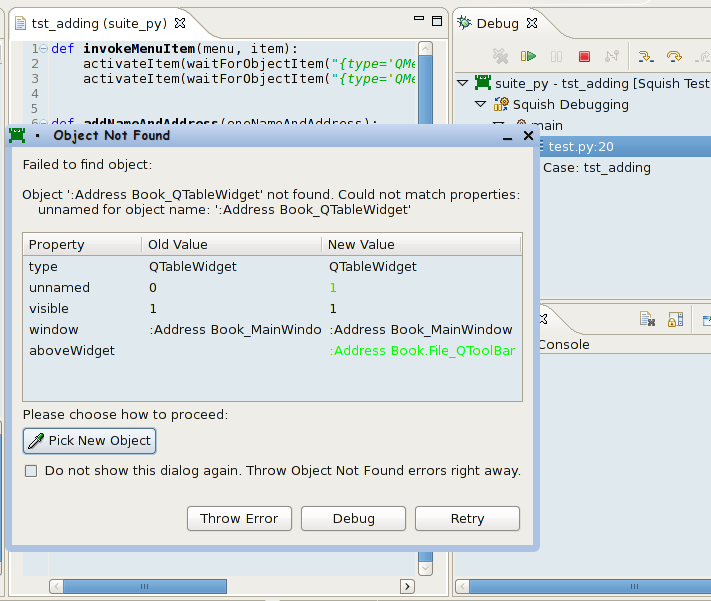Object Not Found
The Object Not Found dialog automatically opens during the execution of tests if a waitForObject command runs into the specified (or default) timeout.

The dialog shows the error message generated for the lookup error and the object name for which the lookup was executed. You can try to solve the error in the following ways.
Click the Pick New Object button to pick an object from the AUT to compare that object's properties against the ones used for the name so far. This lets you investigate how the properties have changed, and whether they caused the lookup error.

Click the Throw Error button to let the test execution continue and generate the appropriate error. Letting the execution continue at this point may end the test unless the test script catches the lookup error to recover from this itself.
Click the Debug button to close the dialog and open the corresponding name in the object map editor. The Squish IDE is now in the Test Debugging Perspective so you can use all the usual debugging tools to further examine the problem.
Click the Retry button to re-execute the object lookup. It will use the old name if you did not pick a new object, which can be useful to determine whether the lookup error is triggered because the object takes longer to become ready than the default timeout. If you picked a new object, the new object name will be stored under the symbolic name in the object map and the lookup will be performed with that new name.
Select the Do not show this dialog again checkbox and click the Throw Error button to hide the dialog on any future lookup errors until you re-enable it in the Playback preferences pane.
Note: The Pick New Object button is only available if the object lookup error happened for a symbolic name found in the object map. If the symbolic or real name is assembled inside the test script, this option is disabled as the Squish IDE cannot properly update the object map.
© 2025 The Qt Company Ltd.
Documentation contributions included herein are the copyrights of
their respective owners.
The documentation provided herein is licensed under the terms of the GNU Free Documentation License version 1.3 as published by the Free Software Foundation.
Qt and respective logos are trademarks of The Qt Company Ltd. in Finland and/or other countries worldwide. All other trademarks are property
of their respective owners.

